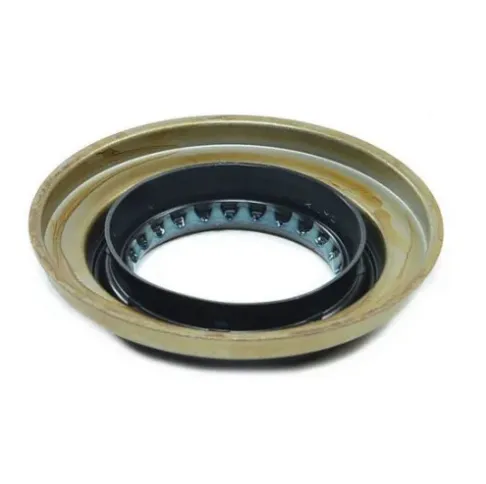Crankshaft Oil Seals: Small Components with a Major Role in Engine Integrity
When it comes to engine performance and longevity, one of the most critical—yet often overlooked—components is the crankshaft oil seal. These seals play a vital role in preventing oil leakage and maintaining internal pressure within the engine. Whether it's the front crankshaft seal or the rear crankshaft seal, failure of these components can lead to costly repairs and serious engine damage if ignored.

What Is a Crankshaft Oil Seal and How Does It Work?
The crankshaft oil seal sometimes referred to simply as a crank seal, is designed to prevent engine oil from leaking at the points where the crankshaft exits the engine block—typically at both the front and rear ends. These seals allow the crankshaft to rotate freely while keeping the oil inside the crankcase, ensuring that all moving parts remain lubricated.
There are two primary types of crankshaft oil seals:
Front crankshaft seal – Located behind the main crankshaft pulley or harmonic balancer, this seal prevents oil from leaking at the front of the engine.
Rear crankshaft seal – Situated at the back of the engine where the crankshaft connects to the flywheel or flexplate, this seal is essential in keeping oil from leaking near the transmission housing.
Both seals are made from durable materials like rubber, silicone, or PTFE (Teflon), and are designed to withstand high temperatures and constant rotation. The key functions of a crank seal include:
Keeping engine oil contained within the crankcase
Maintaining internal pressure and vacuum balance
Preventing contamination of the crankshaft and timing components
The Front Main Seal: Function, Failure Signs, and Maintenance
The front main seal, another name for the front crankshaft seal, plays a crucial role in protecting the timing components and belt system from oil contamination. It is often located behind a timing cover or accessory drive system and is subject to constant movement and pressure.
Signs of a Failing Front Main Seal:
Oil leaks from the front of the engine, especially near the crank pulley
Visible oil on the timing cover or harmonic balancer
Burning oil smell or smoke if oil reaches hot engine parts
Engine oil level dropping more rapidly than normal
Replacement of the front main seal often requires removal of the crankshaft pulley and sometimes even the timing belt or chain—making it a labor-intensive job. However, ignoring this issue can result in oil contaminating timing components, causing slippage or premature failure.
Preventative maintenance includes:
Regular oil changes to reduce sludge buildup
Using proper crankcase ventilation to avoid internal pressure build-up
Inspecting for oil seepage during timing belt replacement or accessory repairs
Rear Crankshaft Seal: Why It’s Often the Most Troublesome
The rear crankshaft seal is one of the most critical and difficult-to-reach seals in any engine. Located between the engine and the transmission, replacing this seal typically involves removing the entire transmission or engine, depending on the vehicle's design.
Despite its inaccessibility, the rear crankshaft seal must operate under significant stress due to crankshaft rotation, engine vibrations, and oil pressure. When this seal fails, it can lead to substantial oil loss and even clutch contamination in manual transmission vehicles.
Symptoms of a Faulty Rear Crankshaft Seal:
Oil leaking between the engine and transmission housing
Clutch slipping or contamination in manual vehicles
Unexplained low oil levels with no obvious leak elsewhere
A pool of oil forming under the center of the vehicle
Because of the difficulty and cost of replacing the rear crankshaft seal, it’s often recommended to inspect and replace it during clutch replacement, flywheel resurfacing, or transmission servicing.
Some high-performance or upgraded seals now use PTFE or Viton materials for extended service life and higher resistance to heat and chemicals.
Crank Seal Replacement: When and Why It Matters
Timely replacement of any crank seal is essential to prevent engine damage. Even small leaks can lead to oil starvation, which in turn causes overheating, bearing wear, and eventual engine failure.
A few key points for vehicle owners and technicians:
Always replace seals with high-quality or OEM components to ensure proper fit and durability.
Consider replacing both front crankshaft seal and rear crankshaft seal during major engine or transmission service, as labor costs will already be absorbed.
Use appropriate sealant or installation tools to avoid misalignment or damage to the seal lip.
Inspect the crankshaft surface for grooves or wear that could compromise sealing effectiveness.
In some cases, a speedy sleeve may be used to restore the crankshaft sealing surface and extend seal life.
The crankshaft oil seal, whether it's the front main seal, rear crankshaft seal, or any type of crank seal, is an essential yet affordable part that protects your engine from internal oil leaks and premature wear. Regular inspection and timely replacement can save you from major engine or transmission repairs down the line.
-
Seal 12x20x5: Precision Radial Shaft Seals for Industrial Reliability
خبریں Nov.24,2025
-
Seal 12x18x5: Essential Guide to Specifications, Applications & Vendors
خبریں Nov.24,2025
-
Understanding Seal 12 20 5: Applications, Specifications & Industry Insights
خبریں Nov.23,2025
-
Durable Oil Seal 85x110x12 – Reliable Sealing Solutions for Industry
خبریں Nov.23,2025
-
Durable and Precise Oil Seal 75x95x10 for Efficient Machinery | YJM Seal
خبریں Nov.22,2025
-
Durable Oil Seal 75x100x10 for Reliable Industrial Performance | YJM Seal
خبریں Nov.22,2025
-
High-Quality Oil Seal 65x90x10 | Durable & Reliable Sealing Solutions
خبریں Nov.22,2025
مصنوعات کے زمرے















